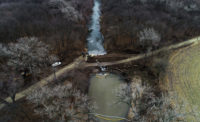In a strongly worded response that was not a surprise to the U.S. military, a San Francisco-based official of the U.S. Environmental Protection Agency has raised concerns about the potentially major environmental and infrastructure damage from the planned relocation of thousands of Marines and others to the tiny Pacific island of Guam.

In a Feb. 17 letter to Roger Natsuhara, acting assistant U.S. Navy secretary for installations and environment, EPA regional administrator Jared Blumenfeld says the impacts “are of sufficient magnitude that EPA believes the action should not proceed as proposed.”
Blumenfeld’s comments make up the agency’s response to the estimated 10,000-page draft environmental impact statement (EIS) the military had to perform to assess the likely harm to Guam’s sensitive ecology and quality of life from the huge buildup of island facilities and infrastructure, projected to cost at least $15 billion to $20 billion over several years. Such assessments are required on federal projects. He says that if EPA concerns are not resolved in a final EIS expected by late summer, the issue may have to be addressed by the White House.
The Navy is managing the construction operation to accommodate the relocation of close to 9,000 Marines from Japan’s Okinawa Island by 2014, as well as the arrival of thousands more dependents, construction workers and others. EPA’s letter says at construction peak, Guam’s current population of 180,000 could increase by 45% and that the EIS “inappropriately excludes” the impact of the new construction forces and population growth.
Blumenfeld says EPA’s “unsatisfactory” rating of the EIS is based primarily on inadequate attention to water and wastewater infrastructure impacts on Guam and on “unacceptable” effects on 71 acres of “high-quality” coral reefs in Apra Harbor, where the Navy plans to enlarge pier facilities to accommodate aircraft carriers. He says the EIS does not offer “viable plans” for mitigating risks for the island’s population beyond those directly linked to the military.
EPA is concerned about significant drawdown of a key drinking-water aquifer, more raw sewage spills and air-quality impacts from greater use of high-sulfur fuel for power and transportation.
According to Blumenfeld, the buildup “will significantly exacerbate” already strained infrastructure and public-health concerns on Guam. He says EPA has had to ramp up enforcement over the last seven years to raise conditions to U.S. standards.
“We do not suggest that DOD is responsible for existing conditions on Guam; however, the additional burden placed on existing conditions by the military realignment” is a DOD priority, says the EPA official. He urges a “coordinated approach” among federal and military agencies and Guam’s government to “avoid the creation of two Guams.”
Blumenfeld says EPA “strongly supports looking at how the military buildup can advance the goal of one Guam” and how all participants “can get it right.”
Marine Corps Major Neil Ruggiero, spokesman for the Navy’s Joint Guam Program Office (JGPO), which is managing the buildup, says that while military officials have collaborated with EPA in drafting the EIS, “we fully anticipated that formal agency comments would point out deficiencies and areas requiring revision.” He says DOD “is determining how best to address these issues in the final EIS.”
David F. Bice, a retired Marine Corps general who is now JGPO executive director, says the final EIS, set for completion “in late summer,” would be followed by a so-called record of decision in about 30 days that would incorporate public comment. Bice says the military intends to start constuction before the end of the current fiscal year, at the end of September.





Post a comment to this article
Report Abusive Comment